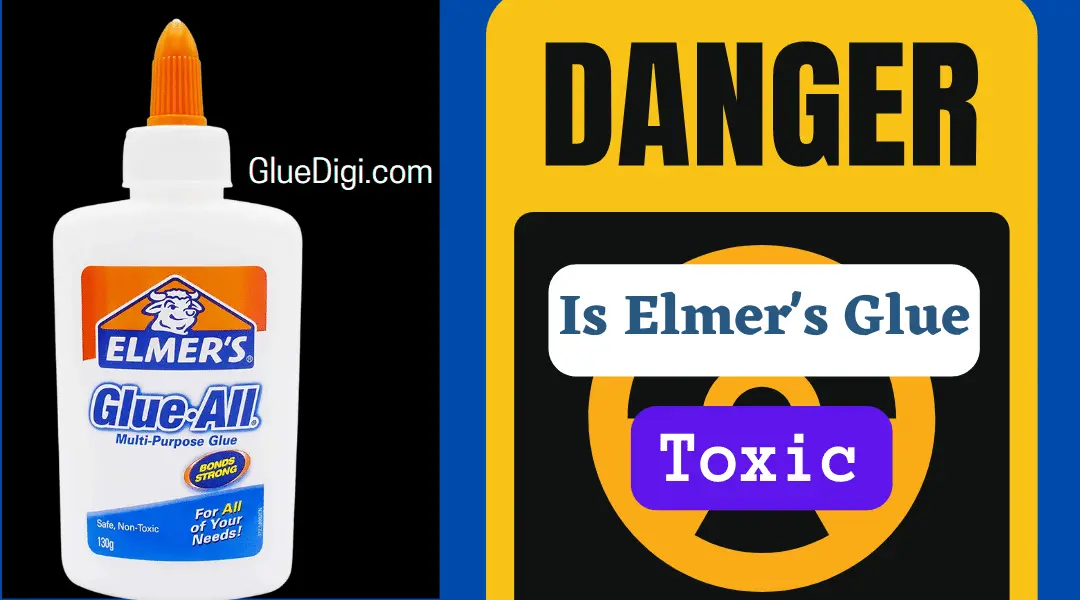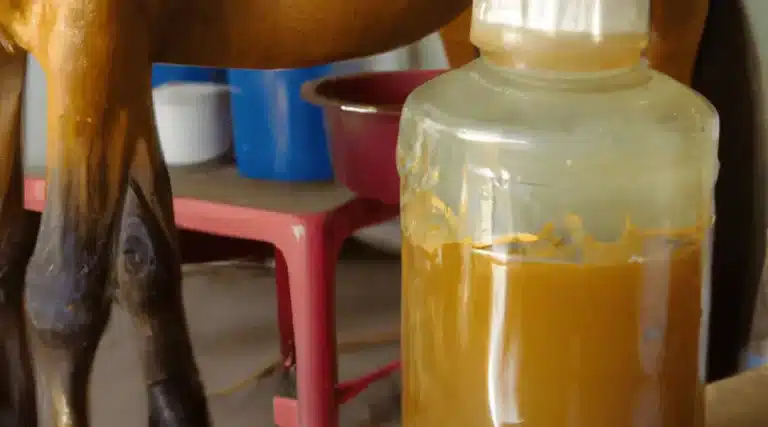Do you have a question about Elmer’s glue? Want to know Is Elmer’s Glue is toxic? Need to know how long it takes to dry? Curious about what it smells like? We’re here to answer all your questions.
Elmer’s glue finds itself on the long list of peculiar items people may consider consuming or, at the very least, are tempted to taste. From chalk and crayons to clay and Play-Doh, our inner child sometimes leads us to explore the boundaries of what’s fit for consumption. However, before you decide to sample Elmer’s glue, there are some essential facts you should be aware of.
Elmer’s Glue is Non-Edible But Safe
Elmer’s glue is not intended for consumption, though it is considered non-toxic and food-safe. The reason behind its inedibility lies in its composition: our bodies cannot digest the petroleum-based polymer used in making the glue. Ingesting it can lead to digestive issues or an upset stomach. Moreover, consuming dried-on chunks of the glue may even pose a risk of intestinal obstruction.
In this article, we’ll explore the reasons behind the misconception that Elmer’s glue is edible and clarify why it is not, despite being labeled as non-toxic and food-safe.
What Is the Toxicity Level of Elmer’s Glue?
Let’s start by being clear about one thing: Elmer’s glue is non-toxic. According to the company’s website, every product is “AP certified non-toxic and safe.” This indicates that a toxicologist has examined them and determined that both children and adults may safely use them. This does not imply that you should intentionally ingest it, though.
Although Elmer’s glue is non-toxic, it can nevertheless be harmful if consumed in excessive doses, it should be noted. Gastrointestinal discomfort, including nausea and vomiting, can result from ingesting glue. Glue can also result in digestive tract obstructions, which can be a significant medical issue.
Furthermore, even though Elmer’s glue is generally safe to use, some people could react negatively to it due to allergies. Skin irritation, hives, and breathing problems are all examples of allergic response symptoms. It’s critical to get medical assistance right away if you suffer any of these after using Elmer’s glue.
What Are the Ingredients of Elmer’s Glue?
Elmer’s glue is made primarily of polyvinyl acetate (PVA), a synthetic polymer that forms a strong bond when it dries. Other ingredients include water, ethanol, and various stabilizers and thickeners. None of these drugs have a particularly bad reputation when used as instructed. However, it’s best to stay away from drinking it.

Aside from its primary use as an adhesive, Elmer’s glue can also be used for various arts and crafts projects. It can be mixed with paint to create a unique texture or used as a sealant for paper mache projects. Additionally, Elmer’s glue can be used as a temporary fix for small cracks or holes in walls or furniture.
Elmer’s glue has been a popular choice for school projects and crafts for decades. It was first introduced in the United States in the 1940s and has since become a household name. The company has also expanded its product line to include other types of adhesives, such as glue sticks and spray adhesives.
Why Some People Think Elmer’s Glue Is Edible
The confusion surrounding the edibility of Elmer’s glue can be attributed to a historical misconception. This misunderstanding arose from the branding of the product. Elmer’s Glue is named after Elmer the Bull, the iconic character featured on its packaging. Elmer was introduced in 1940 by David William Raid, a member of the advertising team that had previously created Elsie the Cow in 1936.
In advertising, Elmer the Bull and Elsie the Cow were depicted as a married couple. Often appearing in various promotional campaigns along with their offspring. By the time Elmer became the face of Borden’s adhesive product line in 1951, many Americans and Canadians were already familiar with him. As he was closely associated with Elsie, the well-known mascot for dairy products. This connection led some to believe that Elmer’s glue contained milk due to its association with Elsie.
The other reason for the misconception is the earlier version of Elmer’s glue, known as Cascorez Glue, which did contain casein. Casein is a type of protein found in cow’s milk, which contributed to the belief that the glue was derived from milk.
However, the truth is that as synthetic glue became more cost-effective in the 20th century, the manufacturer transitioned to using a petroleum-based polymer called PVA to produce Elmer’s glue. Therefore, the current version of Elmer’s glue does not contain any animal-based components, nor is it made from milk or any animal byproducts.
Why Elmer’s Glue Isn’t Edible
Elmer’s glue is classified as non-toxic and food-safe, which means that accidental ingestion is not likely to result in severe harm. However, these designations do not make Elmer’s glue edible due to its indigestible nature and lack of nutritional value.
To clarify, being non-toxic implies that it will not poison you or cause adverse health effects. For something to be poisonous when ingested, it must be digested and absorbed into the bloodstream, where it can interact with body cells or molecules to cause harm. Since Elmer’s glue is indigestible, it cannot be absorbed into the body.
The label “food-safe” is applied because Elmer’s glue dries into an inert, hard plastic that is safe for use in areas where it may come into contact with food. The term “edible” describes something that is both safe to ingest and digestible, and these terms have similar meanings in the context of consumability.
In summary, Elmer’s glue is not considered edible for two primary reasons. Firstly, it is not digestible, and secondly, although small amounts are not likely to cause severe harm, consuming a substantial quantity may result in digestive discomfort and an unpleasant experience.
Moreover, how you consume Elmer’s glue matters. Swallowing a dried-out chunk of the glue may lead to an obstruction in your digestive tract, potentially causing more serious problems than a simple stomachache.
Assessing the Effects of Elmer’s Glue on Skin
In especially if you have sensitive skin, Elmer’s glue on your skin might cause minor discomfort or redness. But this should only last a short while and shouldn’t harm you permanently. You can often remove the adhesive with soap and water. Do not attempt to remove it forcefully. As an alternative, you may wash your garments with hot water and soap to get rid of the odor.
You should seek medical assistance if you have Elmer’s glue on your skin and develop any severe or protracted symptoms, such as blistering or persistent redness. T prevent putting glue on your skin in the first place, doctors also advise wearing gloves or applying a barrier lotion. Use any adhesive product according to the directions and always read the label.
Exploring the Hazards of Inhaling Elmer’s Glue
If you inhale Elmer’s glue, you could experience some respiratory irritation or even temporary respiratory depression (slowed breathing). However, this is generally only a risk if you’re working with large quantities of glue in an unventilated space. If you do start to feel sick after inhaling glue fumes, move to a well-ventilated area immediately and seek medical attention if necessary.
It is important to remember that breathing in Elmer’s glue might have long-term implications on one’s health. Chronic respiratory issues can result from prolonged exposure to the fumes, which can harm the lungs and respiratory system. In addition, certain glues include dangerous substances like toluene, which, when breathed in significant doses over an extended period, can impair the nervous system. It’s usually advisable to use glue in a space that is properly ventilated and to try to limit your exposure to glue fumes.
Debunking Common Myths about Elmer’s Glue
One common myth about Elmer’s glue is that it can cause hallucinations or other strange effects if you inhale or ingest it. The claim that using Elmer’s glue as directed can have any significant effects lacks evidence, and any reported effects are likely due to the placebo effect or suggestibility. Additionally, some people mistakenly believe that animals such as horses contribute to Elmer’s glue production, but this is false. As discussed earlier, the manufacturers primarily make Elmer’s glue using a synthetic polymer called PVA.
Elmer’s glue is generally safe to use, however, some people may react allergically to it. An allergic response may include swelling, redness, and itching. After using Elmer’s glue, cease using it right away and seek medical advice if you have any of these symptoms.
Additionally, in some situations, Elmer’s glue shouldn’t be used in place of professional-grade adhesives. For instance, it could not be resilient enough to survive extremely high or low temperatures. Use Elmer’s glue or any other adhesive product according to the manufacturer’s directions and always read the label.
Conclusion
Is Elmer’s Glue Toxic? In conclusion, Elmer’s glue is generally regarded as being safe to use when applied to product instructions. However, it is not advisable to use the glue in methods that are not recommended by the maker or consume it on purpose. Seek medical help as quickly as you can if you accidentally consume glue or if you have any other problems.






